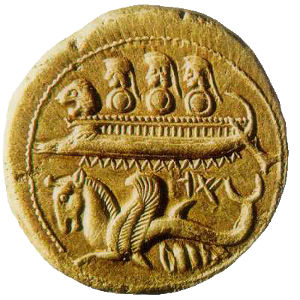Prows with eyes on Phoenician ships
Phoenician ships had large eyes on their prows, perhaps because an Egyptian name for such “lookout” eyes sounded a bit like Phoenicians. A similar pun are the horse-head prows.
Phoenician ships with eyes
Phoenician ships are often depicted as having large eyes painted, or even built & mounted on their prows. There are almost no contemporary depictions, as there are few uncensored relics from Phoenicia anyway. It’s mostly coins offered on commercial collectors’ sites.

Phoenician coin depicting a ship with an eye on its prow.
However, pretty much all later sources claim that Phoenician ships had these eyes, as did many Greek & Roman ships.
The general position of the eyes on the upperworks of Classical Greek warships is similar to those that appear on Phoenician warships depicted on the coins of Sidon, Arados, and Byblos, as well as on an engraved gem from Amathus (Betlyon, 1982: 3-38, 77-142, pls. 1-4, 6-9; Basch, 1987: 328, fig. 702).
Egyptian nhs for “lookout” used for eyes on ship
But the custom of eyes on ships’ prows goes back even to the Ancient Egyptians. The general style of such eyes was the famous Egyptian Wedjat eye (probably another pun on its own).
According to the Egyptologist Wallis Budge, one Egyptian name for precisely these eyes on the prow was nhs, which means “awake” & “lookout”, presumably because the lookout on a boat has to be awake even at night.
And nhs is already close enough to √nks for a “phoenix” pun: If you slap a verb with P in front of that word, perhaps Egyptian wp for “open”, then you’ll get wp-nhs for “open lookout [eyes]”. This was probably close enough to pn-nks to count as a pun with “Phoenician” for the Phoenicians. And that’s probably why it’s always stressed that Phoenicians had eyes on their prows, just as with the horse-head prows.
(Of course the the prow eyes were also used because they were decorative, and perhaps inspired sailors to stay “awake” during lookout shift.)
Egyptian nhs = wake, awake, lookout, eyes on prow
𓈖𓉔𓋴𓍞𓁻 nhsj : wake — Egyptian (AED)
𓈖𓉔𓊃𓁺 nhzj : to awaken; to be awake — Egyptian (TLA)
𓈖𓉔𓊃 ; 𓈖𓉔𓊃𓁻 nehes : to wake, to rouse from sleep; Coptic ⲛⲉϩⲥⲉ — Egyptian (Budge)
𓈖𓉔𓋴 nehesȧ : the look-out man on a boat — Egyptian (Budge)
𓈖𓉔𓋴 Nehesȧ : the “look-out” god in the boat of Af — Egyptian (Budge)
𓈖𓉔𓋴𓍞𓁻𓏭𓅱 nehs-iu : the two Utchats which were painted on the two sides of the front of a boat to keep a look-out — Egyptian (Budge)
Egyptian wp = open
𓅱𓊪𓄋 wpj : open — Egyptian (AED)
